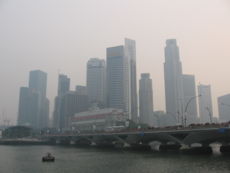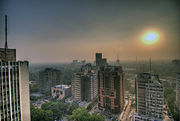Smog
2008/9 Schools Wikipedia Selection. Related subjects: Environment
| Air pollution |
| Acid rain • Air Quality Index • Atmospheric dispersion modeling • Chlorofluorocarbon • Global dimming • Global warming • Indoor air quality • Ozone depletion • Particulate • Smog |
| Water pollution |
| Eutrophication • Hypoxia • Marine pollution • Marine debris • Ocean acidification • Oil spill • Ship pollution • Surface runoff • Thermal pollution • Wastewater • Waterborne diseases • Water quality • Water stagnation |
| Soil contamination |
| Bioremediation • Herbicide • Pesticide • Soil Guideline Values (SGVs) |
| Radioactive contamination |
| Actinides in the environment • Environmental radioactivity • Fission product • Nuclear fallout • Plutonium in the environment • Radiation poisoning • Radium in the environment • Uranium in the environment |
| Other types of pollution |
| Invasive species • Light pollution • Noise pollution • Radio spectrum pollution • Visual pollution |
| Inter-government treaties |
| Montreal Protocol • Kyoto Protocol • CLRTAP • OSPAR |
| Major organizations |
| DEFRA • EPA • Global Atmosphere Watch • EEA • Greenpeace • American Lung Association |
| Related topics |
| Environmental Science • Natural environment |
Smog is a kind of air pollution; the word "smog" is a portmanteau of smoke and fog. Classic smog results from large amounts of coal burning in an area and is caused by a mixture of smoke and sulfur dioxide. Modern smog does not usually come from coal but from vehicular and industrial emissions that are acted on in the atmosphere by sunlight to form secondary pollutants that also combine with the primary emissions to form photochemical smog.
Origin of term
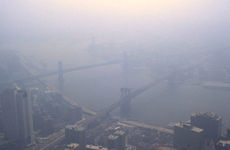
Coinage of the term "smog" is generally attributed to Dr. Henry Antoine Des Voeux in his 1905 paper, “Fog and Smoke,” for a meeting of the Public Health Congress. The 26 July 1905 edition of the London newspaper Daily Graphic quoted Des Voeux, “He said it required no science to see that there was something produced in great cities which was not found in the country, and that was smoky fog, or what was known as ‘smog.’” The following day the newspaper stated that “Dr. Des Voeux did a public service in coining a new word for the London fog.”
"Smog" also appears in a Jan. 19, 1893, Los Angeles Times article and is attributed to "a witty English writer."
Photochemical smog
In the 1950s a new type of smog, known as photochemical smog, was first described.
This forms when sunlight hits various pollutants in the air and forms a mix of inimical chemicals that can be very dangerous. A photochemical smog is the chemical reaction of sunlight, nitrogen oxides (NOx) and volatile organic compounds (VOCs) in the atmosphere, which leaves airborne particles (called particulate matter) and ground-level ozone.
Nitrogen oxides are released by nitrogen and oxygen in the air reacting together under high temperature such as in the exhaust of fossil fuel-burning engines in cars, trucks, coal power plants, and industrial manufacturing factories. VOCs are released from man-made sources such as gasoline, paints, solvents, pesticides, and biogenic sources, such as pine and citrus tree emissions.
This noxious mixture of air pollutants can include the following:
- nitrogen oxides, such as nitrogen dioxide
- tropospheric ozone
- volatile organic compounds (VOCs)
- peroxyacyl nitrates (PAN)
- aldehydes (R'O)
All of these chemicals are usually highly reactive and oxidizing. Photochemical smog is therefore considered to be a problem of modern industrialization. It is present in all modern cities, but it is more common in cities with sunny, warm, dry climates and a large number of motor vehicles. Because it travels with the wind, it can affect sparsely populated areas as well.

Health effects
Smog is a problem in a number of cities and continues to harm human health. Ground-level ozone, sulfur dioxide, nitrogen dioxide and carbon monoxide are especially harmful for senior citizens, children, and people with heart and lung conditions such as emphysema, bronchitis, and asthma. It can inflame breathing passages, decreasing the lungs' working capacity, and causing shortness of breath, pain when inhaling deeply, wheezing, and coughing. It can cause eye and nose irritation and it dries out the protective membranes of the nose and throat and interferes with the body's ability to fight infection, increasing susceptibility to illness. Hospital admissions and respiratory deaths often increase during periods when ozone levels are high .
The U.S. EPA has developed an Air Quality index to help explain air pollution levels to the general public. 8 hour average ozone concentrations of 85 to 104 ppbv are described as "Unhealthy for Sensitive Groups", 105 ppbv to 124 ppbv as "unhealthy" and 125 ppb to 404 ppb as "very unhealthy" . The "very unhealthy" range for some other pollutants are: 355 μg m-3 - 424 μg m-3 for PM10; 15.5 ppbv - 30.4ppbv for CO and 0.65 ppbv - 1.24 ppbv for NO2
The Ontario Medical Association announced that smog is responsible for an estimated 9,500 premature deaths in the province each year.
Areas affected
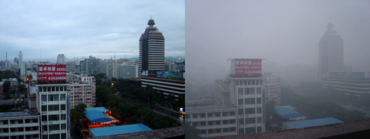
Smog can form in almost any climate where industries or cities release large amounts of air pollution. However, it is worse during periods of warmer, sunnier weather when the upper air is warm enough to inhibit vertical circulation. It is especially prevalent in geologic basins encircled by hills or mountains. It often stays for an extended period of time over densely populated cities or urban areas, such as London, New York, Los Angeles, Mexico City, Houston, Toronto, Athens, Beijing, Hong Kong, the Randstad or Ruhr Area and can build up to dangerous levels.
Historically, there have been acute incidents where smog has killed thousands of people in a single metropolitan area.
London
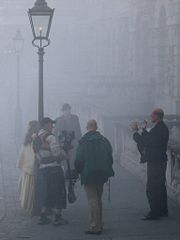
London has been known for smog since Roman times. In 1306, concerns over air pollution were sufficient for Edward I to (briefly) ban coal fires in London. In 1661, John Evelyn's Fumifugium suggested burning fragrant wood instead of mineral coal, which he believed would reduce coughing. The Ballad of Gresham College the same year describes how the smoke "does our lungs and spirits choke, Our hanging spoil, and rust our iron."
Severe episodes of smog continued in the 19th century and were nicknamed "pea-soupers". The Great Smog of 1952 darkened the streets of London and killed approximately 4,000 people in the short time of 4 days (a further 8,000 died from its effects in the following weeks and months). Initially a flu epidemic was blamed for the loss of life. In 1956 the Clean Air Act introduced smokeless zones in the capital. Consequently, reduced sulfur dioxide levels made the intense and persistent London smog a thing of the past. It was after this the great clean-up of London began and buildings recovered their original stone façades which, during two centuries, had gradually blackened. Smog caused by traffic pollution, however, does occur in modern London.
Mexico City
Due to its location in a highland "bowl", cold air sinks down onto the urban area of Mexico City, trapping industrial and vehicle pollution underneath, and turning it into the most infamous smog-plagued city of Latin America. Within one generation, the city has changed from being known for some of the cleanest air of the world into one with some of the worst pollution, with pollutants like nitrogen dioxide breaching international health standards by 2-3 times.
Los Angeles
Being in a low basin surrounded by mountains, Los Angeles is notorious for its smog. The millions of vehicles in the city due to lack of sufficient public transportation and/or to Angelino's preference for private transportation, plus the added effects of the Los Angeles/ Long Beach port complex contribute to further air pollution in the city. While strict regulations by the Californian government have reduced the number of Stage 1 smog alerts from several hundred annually to just a few annually, Los Angeles' pollution level still exceeds health standards and is a pressing issue for the more than 15 million people who live there.
Tehran
In December 2005, schools and public offices had to close in Tehran, Iran and 1600 people were taken to hospital, in a severe smog blamed largely on unfiltered car exhaust.
United States
The United States Environmental Protection Agency has designated over 300 U.S. counties to be non-attainment areas for one or more pollutants tracked as part of the National Ambient Air Quality Standards. These areas are largely clustered around large metropolitan areas, with the largest contiguous non-attainment zones in California and the Northeast. Various U.S. and Canadian government agencies collaborate to produce real-time air quality maps and forecasts.
Major incidents in the US
- 1948, October 30-31, Donora, PA: 20 died, 600 hospitalized, thousands more stricken. Lawsuits were not settled until 1951.
- 1953, November, New York: Smog kills between 170 and 260 people.
- 1954, October, Los Angeles: heavy smog shuts down schools and industry for most of the month.
- 1963, New York: blamed for 200 deaths
- 1966, New York: blamed for 169 deaths
Southeast Asia
Smog is a regular problem in Southeast Asia caused by land and forest fires in Indonesia, especially Sumatra and Kalimantan, although the less political term haze is preferred in describing the problem. Farmers and plantation owners are usually responsible for the fires, which they use to clear tracts of land for further plantings. Those fires mainly affect Brunei, Indonesia, Philippines, Malaysia, Singapore and Thailand, and occasionally Guam and Saipan The economic losses of the fires in 1997 have been estimated at US$9.3 billion . This includes damages in agriculture production, destruction of forest lands, health, transportation, tourism, and other economic endeavours. Not included are social, environmental, and psychological problems and long-term health effects. The latest bout of haze to occur in Malaysia, Singapore and the Malacca Straits is in October 2006, and was caused by smoke from fires in Indonesia being blown across the Straits of Malacca by south-westerly winds.
The Association of Southeast Asian Nations (ASEAN) reacted and signed Agreement on Transboundary Haze Pollution, formed a Regional Haze Action Plan (RHAP) and established a co-ordination and support unit (CSU). RHAP, with the help of Canada, established a monitoring and warning system for forest/vegetation fires and implemented a Fire Danger Rating System (FDRS). The Malaysian Meteorological Service (MMS) has issued a daily rating since September 2003. The Indonesians have been ineffective at enforcing legal policies on errant farmers.
Natural causes
An erupting volcano can also emit high levels of sulfur dioxide, creating volcanic smog, or vog.
Pollution index
The severity of smog is often measured using automated optical instruments such as Nephelometers, as haze is associated with visibility and traffic control in ports. Haze however can also be an indication of poor air quality though this is often better reflected using accurate purpose built air indexes such as the American Air Quality Index, the Malaysian API (Air Pollution Index) and the Singaporean Pollutant Standards Index.
In hazy conditions, it is likely that the index will report the suspended particulate level. The disclosure of the responsible pollutant is mandated in some jurisdictions.
The American AQI is divided into six colour coded categories. Technically AQI runs only from 0 to 500. The 301 to 500 range is categorised as hazardous and colored maroon.
The Malaysian API does not have a capped value; hence its most hazardous readings can go above 500. Above 500, a state of emergency is declared in the affected area. Usually, this means that non-essential government services are suspended, and all ports in the affected area are closed. There may also be prohibitions on private sector commercial and industrial activities in the affected area excluding the food sector. So far, state of emergency rulings due to hazardous API levels were applied to the Malaysian towns of Port Klang, Kuala Selangor and the state of Sarawak during the 2005 Malaysian haze and the 1997 Southeast Asian haze.


